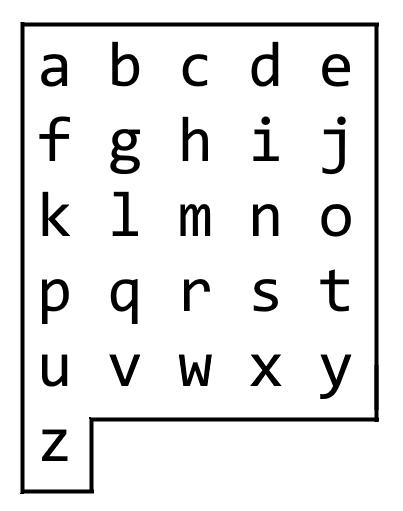LeetCode-in-Java
1138. Alphabet Board Path
Medium
On an alphabet board, we start at position (0, 0), corresponding to character board[0][0].
Here, board = ["abcde", "fghij", "klmno", "pqrst", "uvwxy", "z"], as shown in the diagram below.

We may make the following moves:
'U'moves our position up one row, if the position exists on the board;'D'moves our position down one row, if the position exists on the board;'L'moves our position left one column, if the position exists on the board;'R'moves our position right one column, if the position exists on the board;'!'adds the characterboard[r][c]at our current position(r, c)to the answer.
(Here, the only positions that exist on the board are positions with letters on them.)
Return a sequence of moves that makes our answer equal to target in the minimum number of moves. You may return any path that does so.
Example 1:
Input: target = “leet”
Output: “DDR!UURRR!!DDD!”
Example 2:
Input: target = “code”
Output: “RR!DDRR!UUL!R!”
Constraints:
1 <= target.length <= 100targetconsists only of English lowercase letters.
Solution
public class Solution {
public String alphabetBoardPath(String target) {
if (target.isEmpty()) {
return "";
}
int sourceRow = 0;
int sourceCol = 0;
StringBuilder path = new StringBuilder();
for (char c : target.toCharArray()) {
int position = c - 97;
int targetRow = position / 5;
int targetCol = position % 5;
if (targetCol < sourceCol) {
path.append(helper("L", sourceCol - targetCol));
}
if (targetRow < sourceRow) {
path.append(helper("U", sourceRow - targetRow));
}
if (targetRow > sourceRow) {
path.append(helper("D", targetRow - sourceRow));
}
if (targetCol > sourceCol) {
path.append(helper("R", targetCol - sourceCol));
}
path.append("!");
sourceRow = targetRow;
sourceCol = targetCol;
}
return path.toString();
}
public StringBuilder helper(String dir, int time) {
StringBuilder path = new StringBuilder();
path.append(String.valueOf(dir).repeat(Math.max(0, time)));
return path;
}
}

